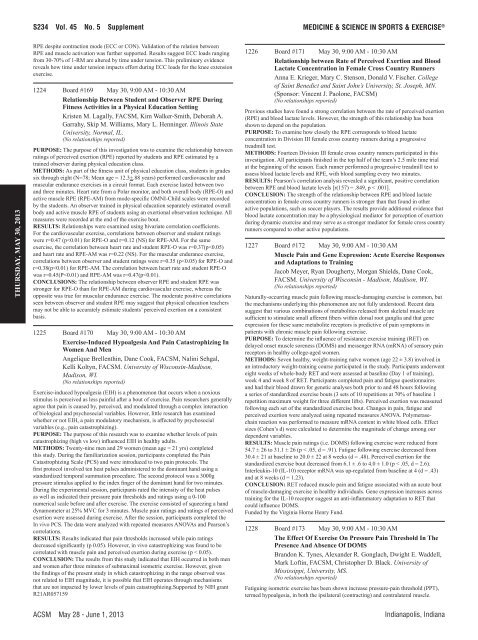Thursday-Abstracts
Thursday-Abstracts
Thursday-Abstracts
You also want an ePaper? Increase the reach of your titles
YUMPU automatically turns print PDFs into web optimized ePapers that Google loves.
<strong>Thursday</strong>, May 30, 2013<br />
S234 Vol. 45 No. 5 Supplement<br />
RPE despite contraction mode (ECC or CON). Validation of the relation between<br />
RPE and muscle activation was further supported. Results suggest ECC loads ranging<br />
from 30-70% of 1-RM are altered by time under tension. This preliminary evidence<br />
reveals how time under tension impacts effort during ECC loads for the knee extension<br />
exercise.<br />
1224 Board #169 May 30, 9:00 AM - 10:30 AM<br />
relationship Between student and Observer rPE during<br />
Fitness activities in a Physical Education setting<br />
Kristen M. Lagally, FACSM, Kim Walker-Smith, Deborah A.<br />
Garrahy, Skip M. Williams, Mary L. Henninger. Illinois State<br />
University, Normal, IL.<br />
(No relationships reported)<br />
PurPOsE: The purpose of this investigation was to examine the relationship between<br />
ratings of perceived exertion (RPE) reported by students and RPE estimated by a<br />
trained observer during physical education class.<br />
METhOds: As part of the fitness unit of physical education class, students in grades<br />
six through eight (N=78; Mean age = 12.3+.88 years) performed cardiovascular and<br />
muscular endurance exercises in a circuit format. Each exercise lasted between two<br />
and three minutes. Heart rate from a Polar monitor, and both overall body (RPE-O) and<br />
active muscle RPE (RPE-AM) from mode-specific OMNI-Child scales were recorded<br />
by the students. An observer trained in physical education separately estimated overall<br />
body and active muscle RPE of students using an exertional observation technique. All<br />
measures were recorded at the end of the exercise bout.<br />
rEsuLTs: Relationships were examined using bivariate correlation coefficients.<br />
For the cardiovascular exercise, correlations between observer and student ratings<br />
were r=0.47 (p


